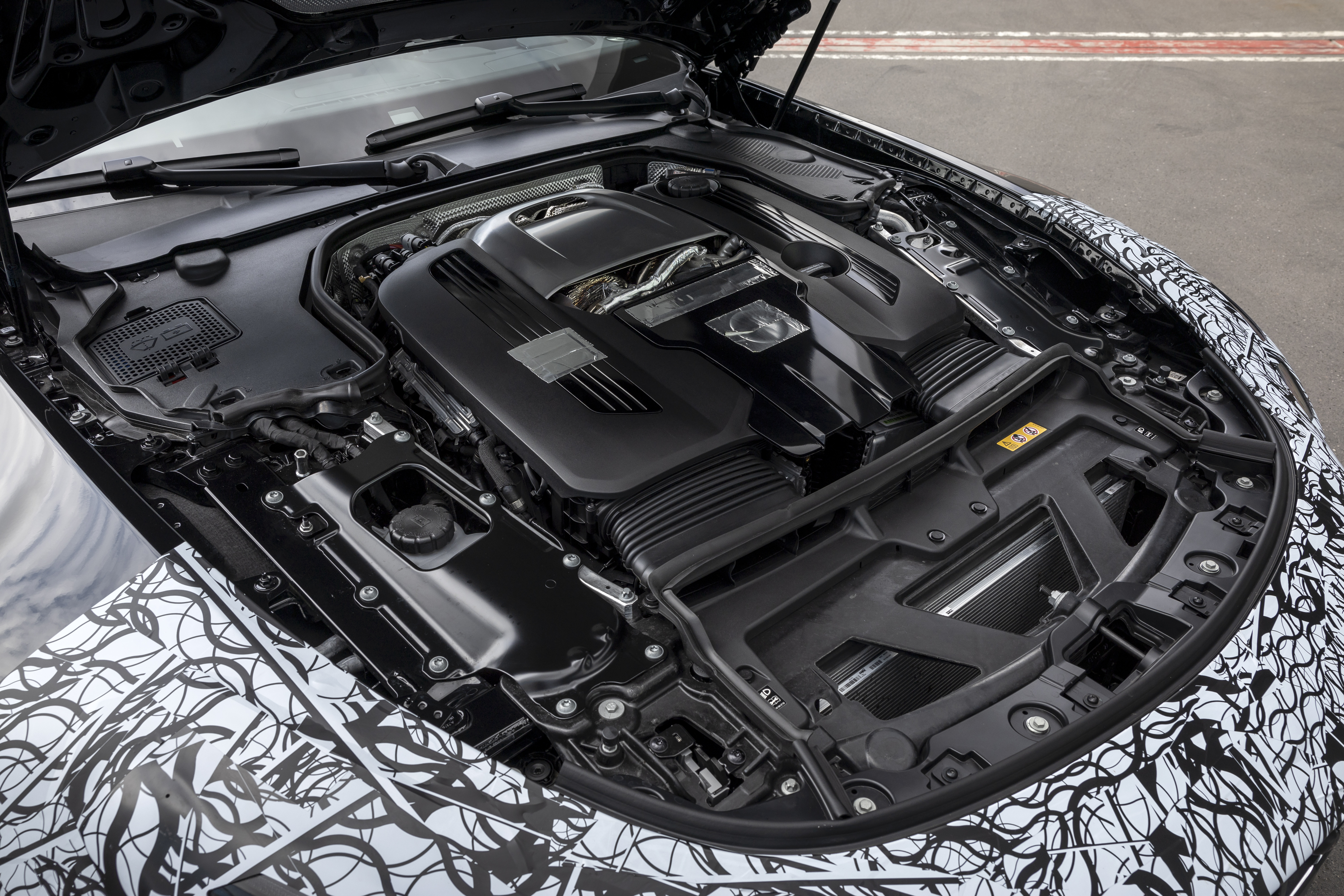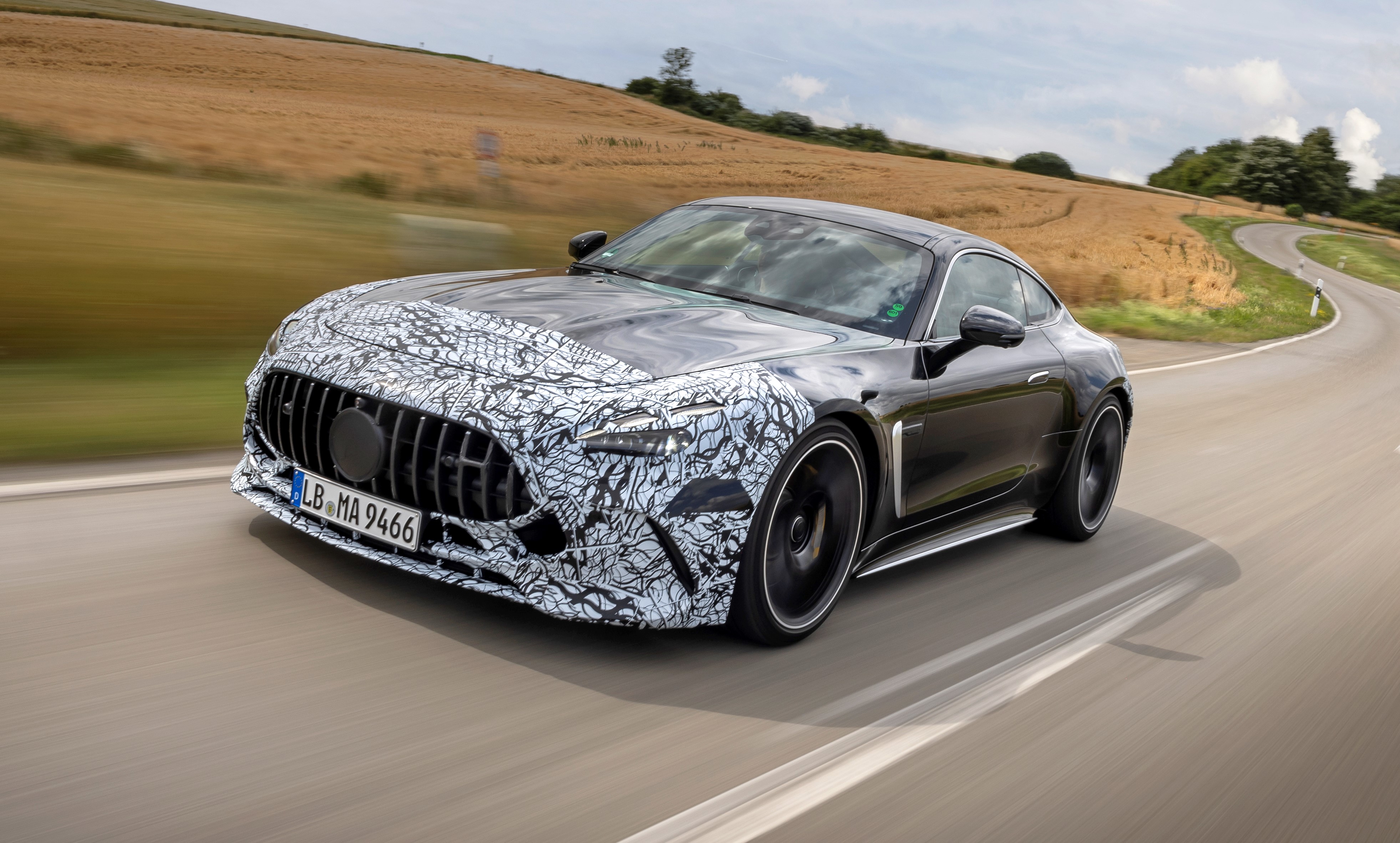AFFALTERBACH, GERMANY – In a world of increasingly futuristic electric-powered road cars, the Mercedes-AMG GT plays a distinctly traditional tune.
A compelling front-engine sports car from the conventional school of automotive engineering, it manages to set the pulse racing with a boisterous and powerful twin-turbocharged 4.0L gasoline V-8 and true knife-edge rear-wheel-drive handling.
Since its launch in 2014 as a successor to the gullwing SLS, it has established Mercedes-Benz’s AMG performance-car division as a genuine force in the sports-car ranks alongside competition with an impressive pedigree, including the rear-engine Porsche 911, both on the road and the track.
So, after nearly nine years of production, what’s next? More of the same, or perhaps something different again?
Mercedes-AMG invited Wards to find out in a brief ride in the new second-generation GT around its headquarters here on the outskirts of Stuttgart. The new model, to be unveiled at the upcoming 2023 Munich auto show, is paired with the latest SL.
Both AMG models are based on the same Modular Sport Architecture (MSA) platform – a lightweight spaceframe that uses a combination of aluminum, steel, magnesium and plastic composites. They will be produced alongside each other at parent company Mercedes-Benz’s Bremen plant in Germany.
 When we arrive at AMG, we’re met by its new CEO, Michael Schiebe (pictured, left). The 39-year-old German, who also heads up Mercedes-Benz’s G-Class and Maybach sub-brands as part of the German automaker’s so-called Top End Vehicle group, has only been in the job four months. But despite his busy schedule, he’s agreed to take us for a brief drive in a pre-production GT prototype.
When we arrive at AMG, we’re met by its new CEO, Michael Schiebe (pictured, left). The 39-year-old German, who also heads up Mercedes-Benz’s G-Class and Maybach sub-brands as part of the German automaker’s so-called Top End Vehicle group, has only been in the job four months. But despite his busy schedule, he’s agreed to take us for a brief drive in a pre-production GT prototype.
“Before you ask, yes, we’re only going to build it as a coupe,” he says, pointing at the lightly disguised, black-liveried GT. “There is absolutely no shame in it sharing its DNA with the SL, which takes the roadster role in our portfolio.”
While it shares its platform and much more with the SL, Schiebe says the GT has been conceived to be the more sporting of the two front-engine models.
Dimensionally, the new GT has grown. There are no official just details yet, but expect it to mirror the latest SL with a length of around 185.2 ins. (4,704 mm), which represents an increase of 6.3 ins. (160 mm) over the old model. The wheelbase is extended 2.8 ins. (71 mm) to 106.3 ins. (2,700 mm). This provides the scope for a set of SL-style rear seats in a new 2+2 layout, as well as a much larger trunk underneath a liftback-style tailgate at the rear.
“The feedback we got from customers was to keep the performance but broaden the scope to make it a more amiable car in everyday driving conditions. We’ve got people who use the GT for weekend trips and longer. The added space now allows it to fulfill this role better than the old model,” says Schiebe.
There are significant changes to the drivetrain, too. Initial second-generation models will retain AMG’s twin-turbocharged V-8. Schiebe won’t go into detail on power output and other aspects of the 4.0L unit just yet, but he says it has been engineered with EU7 emissions regulations in mind.
Expect a number of different variants of the reworked engine (pictured, below). Earlier GT models offered between 456 and 724 hp in no less than six different road models, including the top-of-the-line GT Black Series, which zips to 62 mph (100 km/h) in a claimed 3.2 seconds with a 202-mph (325-km/h) top speed.

In a development brought to the SL, the previous Speedshift MCT 7-speed dual-clutch transaxle of the first-generation GT is replaced by a new 9-speed Speedshift MCT dual-clutch gearbox mounted directly to the engine. As before, it offers both manual and automatic shifting.
An even greater change in engineering philosophy for the GT comes with the adoption of a fully variable all-wheel drive system in place of the rear-wheel-drive layout of old.
What is noticeable from the passenger seat is just how close the new model feels to the original. Despite its larger dimensions, more spacious interior and heavily reworked drivetrain, it still feels like a GT. There is the same deep staccato engine sound. The same elongated view down the hood. The same exuberant accelerative force under load in Sport Plus mode. It is traditionally AMG in character despite the changes, including an altered front-to-rear weight distribution.
Schiebe admits the larger dimensions, the new interior layout and the addition of all-wheel drive have inevitably led to an increase in weight. However, he is confident the new model is every bit as dynamically adept, if not more so, as its predecessor.
The AMG CEO says the decision to go with all-wheel drive opens up a new dimension for the GT. “We have a fully variable apportioning of power front-to-rear. That means that you can not only decide to drive to the Alps in June or July but also in October or November, perhaps even January or February. Because you feel safe.”
The message is clear: All-wheel drive gives the new GT the sort of all-season usability its predecessor lacked.
The double-wishbone front and multi-link rear suspension, with variable damping control and active anti-roll functions, are uniquely tuned. The new GT is firmer than the SL, but it gives the impression that it delivers greater compliance and better absorption of road shock than the original model.
“It is our aim to make it the most dynamic model in our portfolio, but at the same time, it is our job to fulfill our customer's wishes,” says Schiebe.
Other observations? The new GT also offers improved vision, both front and rear. It remains sporting, but you’re not as enclosed as before. Schiebe says this makes it a friendlier car in urban driving conditions.

The remaining camouflage does little to hide the new GT’s shape (pictured, above). However, it does obscure some of its more detailed exterior design elements, which are secret until its unveiling in September.
The long hood and frameless doors are shared with the SL. However, there’s a larger grille, a uniquely styled front bumper with a more prominent splitter and additional cooling ducts, new-look headlamps and redesigned front fenders with a vertical air vent positioned behind the front wheel arches to extract hot air away from the engine bay and brakes up front.
Farther back (pictured, below), the ’24-model-year GT sports a fixed roof together with rear side windows and bespoke rear panels. The rear is dominated by the liftback-style tailgate, structured taillamps, quad-chromed tailpipes in a trapezoidal design and a spoiler that automatically deploys from the top of the bumper.

A look around the largely undisguised interior of the new GT reveals it is almost identical to that of the SL. There are digital instruments with AMG graphics and a central 11.9-in. (30-cm) portrait-style infotainment display within the dashboard, as well as the latest AMG double-spoke steering wheel with shift paddles for the gearbox.
The broad front seats get integral headrests in a hard-shell optic, with the rear offering two emergency seats as part of efforts to extend the GT’s everyday usability. The liftback-style tailgate also opens high to reveal a much larger cargo compartment than that of the original model. Expect a long list of options, including a new head-up display unit with augmented-reality functionality.
Will the new GT lineup encompass as many models as its predecessor, which, at last count, numbered 11? “Wait and see,” says Schiebe, adding, “We already offer the SL in 43, 55 and 63 models.”
And what are the chances of a plug-in hybrid variant of the GT? “Let’s get the GT launched before we talk about other drivetrains,” he says.
On the way back to Affalterbach over undulating country roads, Schiebe identifies what he believes are the defining characteristics of AMG’s new flagship. “It is still a supercar with an ability to excite and engage the driver on a very high level. But it now has greater comfort and ease of use. It is a more agreeable car on an everyday basis,” he says, smiling from ear to ear.






